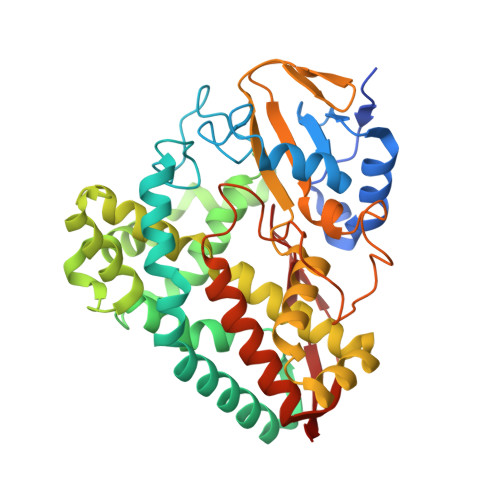Investigating the Active Oxidants Involved in Cytochrome P450 Catalyzed Sulfoxidation Reactions.
Podgorski, M.N., Coleman, T., Churchman, L.R., Bruning, J.B., De Voss, J.J., Bell, S.G.(2022) Chemistry 28: e202202428-e202202428
- PubMed: 36169207
- DOI: https://doi.org/10.1002/chem.202202428
- Primary Citation of Related Structures:
7TP5, 7TP6, 7TQM, 8DYB - PubMed Abstract:
Cytochrome P450 (CYP) heme-thiolate monooxygenases catalyze the hydroxylation of the C-H bonds of organic molecules. This reaction is initiated by a ferryl-oxo heme radical cation (Cpd I). These enzymes can also catalyze sulfoxidation reactions and the ferric-hydroperoxy complex (Cpd 0) and the Fe(III)-H 2 O 2 complex have been proposed as alternative oxidants for this transformation. To investigate this, the oxidation of 4-alkylthiobenzoic acids and 4-methoxybenzoic acid by the CYP199A4 enzyme from Rhodopseudomonas palustris HaA2 was compared using both monooxygenase and peroxygenase pathways. By examining mutants at the mechanistically important, conserved acid alcohol-pair (D251N, T252A and T252E) the relative amounts of the reactive intermediates that would form in these reactions were disturbed. Substrate binding and X-ray crystal structures helped to understand changes in the activity and enabled an attempt to evaluate whether multiple oxidants can participate in these reactions. In peroxygenase reactions the T252E mutant had higher activity towards sulfoxidation than O-demethylation but in the monooxygenase reactions with the WT enzyme the activity of both reactions was similar. The peroxygenase activity of the T252A mutant was greater for sulfoxidation reactions than the WT enzyme, which is the reverse of the activity changes observed for O-demethylation. The monooxygenase activity and coupling efficiency of sulfoxidation and oxidative demethylation were reduced by similar degrees with the T252A mutant. These observations infer that while Cpd I is required for O-dealkylation, another oxidant may contribute to sulfoxidation. Based on the activity of the CYP199A4 mutants it is proposed that this is the Fe(III)-H 2 O 2 complex which would be more abundant in the peroxide-driven reactions.
Organizational Affiliation:
Department of Chemistry, University of Adelaide, Adelaide, SA, 5005, Australia.



















